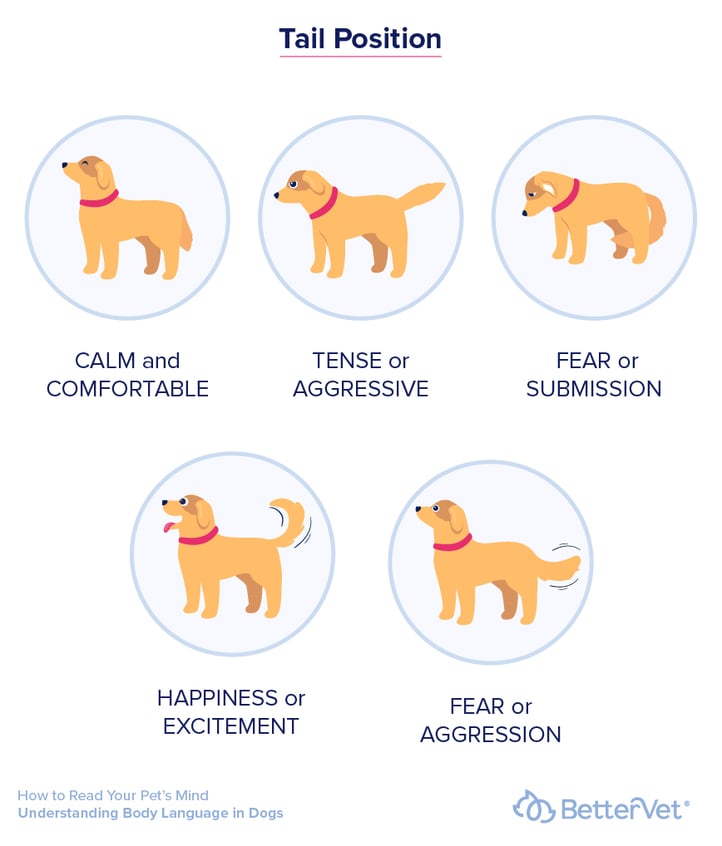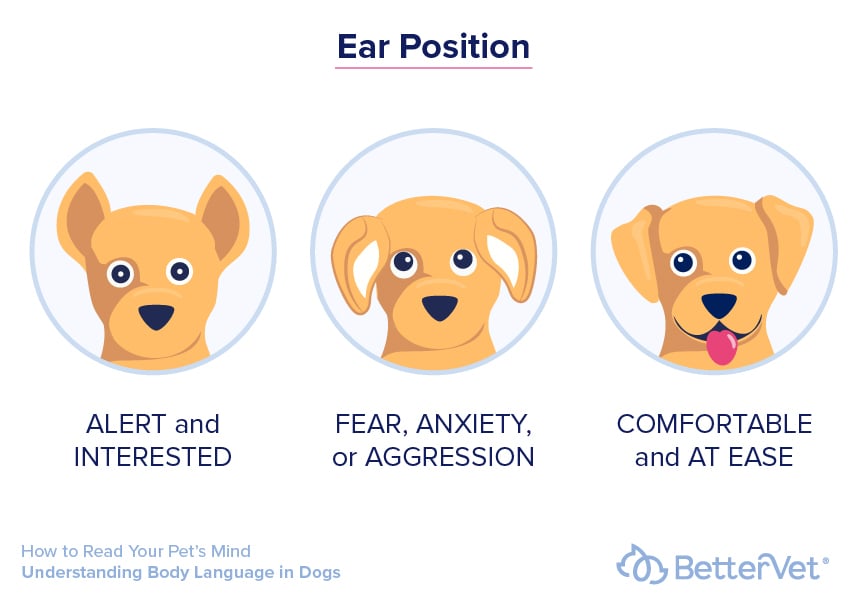How to Read Your Dog's Body Language: 6 Tips

Table of Contents
As a veterinarian who visits pets in their homes, understanding canine communication is crucial. Dogs primarily communicate through body language, and being able to interpret their cues helps us comprehend their emotions, behavior, and health needs. Pet parents also become adept at reading their furry friends' physical cues, which convey hunger, thirst, comfort, and pain.
By exploring the various dog body language cues, you can deepen your understanding of your pet's communication and what those cues signify.
1. Tail Position

The position of a dog's tail can tell us a lot about how they're feeling. A relaxed, neutral tail position indicates that your dog is calm and comfortable.
A tail that is held high and stiff, however, may tell that your dog is feeling tense or even aggressive. A tail that is tucked between the legs may mean fear or submission. Tail wagging can show happiness or excitement, but it can also indicate stress.
A tail held high with fast wagging is usually a sign of excitement, while a low tail with a slow wag can be a sign of fear or aggression. To know how your dog is feeling, it is helpful to look at the whole picture of your dog’s behavior.
2. Ear Position

The position of a dog's ears can tell you a lot about their mood. Ears that are perked up and forward indicate alertness and interest. Ears pulled back against the head may indicate fear, anxiety, or submission. A dog with relaxed, floppy ears is generally comfortable and at ease.
3. Eyes
The eyes, often referred to as the windows to the soul, hold valuable insights into a dog's emotional state. When a dog is relaxed and comfortable, their eyes appear soft and relaxed. However, if a dog feels threatened or aggressive, their eyes may widen, stare intensely, and exhibit dilated pupils. Monitoring a dog's eye contact and understanding the accompanying cues can provide important clues about their emotional well-being.
4. Body Posture
A dog's body posture provides valuable insights into their emotional state. A confident and assertive dog stands tall, with a raised head and a proud chest. On the other hand, a dog exhibiting submissive behavior may hunch over, tuck their tail, and display tense body language.
Another sign of submission is when a dog lies down on their back, exposing their belly. However, it's important to note that this posture can also be a request for attention or affection, such as those irresistible belly rubs!
5. Mouth
A dog's mouth is also an indicator of your dog’s mood. A relaxed, open mouth (with or without the tongue out) may indicate that your dog feels happy, calm, and comfortable. Similarly, panting may be a sign that your dog is hot, or could mean they are anxious or uncomfortable.
A closed mouth with tightly pressed lips may indicate anxiety or tension. A dog that is showing their teeth or snarling is likely feeling aggressive or threatened and caution should be exercised when your dog is approaching people and other pets.
6. Vocalizations
Lastly, a dog's vocalizations, while a form of verbal communication and not body language per se, can also yield important clues as to what’s going on in their mind.
Barking, growling, grunting, and howling can all indicate different emotions, from playfulness to aggression. Pay attention to the tone of your dog's vocalizations as well as the volume and frequency.
Your dog may bark to warn you of danger or to show excitement. They may growl to communicate that they are hungry or need to go outside, but also as a sign of aggression. They may grunt to indicate contentment or to beg for food or attention.
Finally, a dog may howl when they are missing you, are in pain, or to communicate with other dogs. If your dog is howling or vocalizing more than usual and is showing other signs of physical discomfort, you should schedule a behavioral consultation with your veterinarian.
Importance of Reading Your Dog’s Body Language
Here are some common scenarios where understanding your dog's body language can be especially helpful:
1. Meeting New People or Animals
Introducing your dog to new people or animals can be stressful for them, especially if they are not used to socializing. By watching your dog's body language during these introductions, you can get a sense of how they're feeling and intervene if necessary.
If your dog's tail is tucked or their ears are pulled back, for example, they may be feeling fearful or threatened and may need some extra reassurance from you. Growling and showing their teeth tells you that you should remove your dog from the situation immediately.
2. Getting a Vet Checkup
Many dogs find vet visits and exams to be stressful or scary. By watching your dog's body language before a vet visit, you can help them feel more comfortable and calm. Mobile veterinary care is a great option for dogs who are fearful of car rides, carriers, and vet clinics. Our veterinarians are Fear Free certified and experts in reading your pet’s body language.
3. Playing With Other Dogs
Dogs love to play and interact with other dogs, but it's important to monitor their body language during playtime. Sometimes, what may seem like playful behavior to humans may actually be a sign of aggression or discomfort in dogs.
For example, if you are at a dog park and your dog is growling or showing their teeth while playing, it may indicate that they are feeling overwhelmed or threatened. Another red flag is if your or another dog is crouched low onto the ground, as it may be a warning sign that they are ready to charge or attack. Paying attention to your dog's body language during playtime can help prevent fights or injuries.
If your dog seems stressed or is showing signs of aggression with other dogs, you should leave immediately. For help with behavior strategies, a consultation with your veterinarian can be a big help.
4. During Training
Training your dog can be a useful and rewarding experience, but it's important to be mindful of their body language during the sessions. If your dog seems anxious or stressed, it may indicate that they are not comfortable with the training method or are feeling overwhelmed.
On the other hand, if your dog seems relaxed and responsive during training, it may indicate that they are enjoying the process and are ready to learn.
By paying attention to your dog's body language during training, you can adjust your approach as needed to ensure that your dog is happy and engaged.
If you have questions or concerns about your dog’s behavior, schedule a behavior consultation or a telemedicine video consultation with one of our veterinarians.
Conclusion
As veterinarians and pet parents, understanding dog signals is vital for interpreting our furry companions' emotions and needs. While every dog is unique and their body language can be influenced by various factors, paying attention to their cues provides valuable insights. Factors like environment, past experiences, and personality play a role in their body language.
By observing and decoding these signals, we can better understand our dogs' emotions and cater to their needs effectively.
Frequently Asked Questions
Why do dogs turn around in circles before lying down?
Called “trampling,’ this behavior is thought to be an instinctual carryover from when dogs lived in the wild, and was a way to beat down the grass to make sure there aren’t any snakes or dangerous insects in their sleeping area.
Why does my dog stare at me?
It is generally thought that eye contact is a learned behavior from living with humans (aww) and a way to connect, ask for attention, or to express affection. Sometimes, a dog may stare at you when they feel threatened or are ready to attack, so it’s important to read a dog’s other cues as well.
Why does my dog chase their tail?
Tail chasing is a common puppy behavior and is a way to play, burn off that puppy energy, or practice their motor skills. Older dogs also chase their tails too, often in a playful manner.
However, if your adult dog is chasing its tail, in a frenzied way, they may be uncomfortable and trying to reach their rear end. They may be suffering from flea or tick bites or may need their anal glands expressed. Tail chasing as an adult can also be a sign of anxiety.
Reach out to your veterinarian if you think your dog’s tail chasing is a symptom that something is going on with their health.







